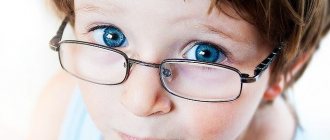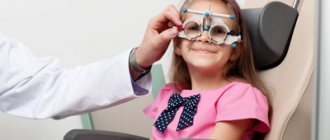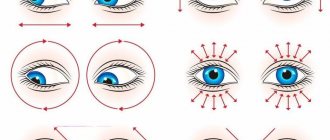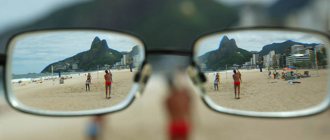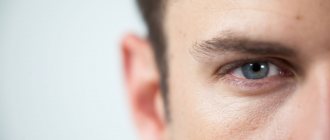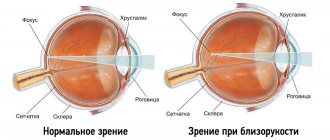Myopia significantly reduces a person's quality of life. One of the progressive methods of therapy for myopia is physical therapy. The common belief that this disease disappears with age due to the development of age-related farsightedness is completely wrong. Therefore, attention should be paid to the condition of the eyes as early as possible. And systematically performing simple exercises will restore and maintain eye health.
Indications for exercise therapy
If a specialist has diagnosed myopia, then the use of exercise therapy will also be recommended. It is necessary to take into account that prescriptions are formed not only based on the diagnosis itself, but also on the degree of development of the disease. Gymnastics for myopia is aimed at working both with the eyes and with those parts of the body that are directly related to the blood supply and innervation of the visual organs.
The range of indications is very wide: it includes all persons suffering from myopia of any degree. Exceptions can only be made in those cases when the diagnosis is accompanied by retinal detachment. Classes from the complex of physical therapy for the eyes will be useful for those who are potentially at risk:
- working at a computer;
- not maintaining the correct visual posture;
- people who are prescribed rehabilitation.
Rules for effective gymnastics
To make eye gymnastics as effective as possible, you should follow some simple rules:
- You should not use all methods at once; it is better to focus on 1-3 methods.
- Any exercises can be performed only after consultation with an ophthalmologist.
- When eliminating myopia, it is recommended to limit the harmful effects on the organs of vision - watching TV, working on the computer, playing on the phone. In addition, you need to reconsider your diet and introduce foods that are good for your eyes into it.
- Gymnastics should be performed calmly, and should not be done in a state of stress or nervousness.
The benefits of physical education
The blood supply to the eyeball improves.
Methods for selecting loads for myopia are aimed at general strengthening of the body, regulating the condition of the neck and head, improving blood supply, strengthening the visual apparatus, normalizing breathing, and improving the condition of muscles and ligaments. There are several degrees of development of the disease. The range of exercises for an average degree of myopia will be narrower than for a low degree, and wider if a high degree is diagnosed.
Insufficient nutrition and blood supply to the organs of vision negatively affects their structure and worsens the situation with myopia. Therefore, it is important to maintain the overall balance of the body in general and associated organs in particular.
When performed regularly, gymnastics for myopia helps:
- improve blood circulation and circulation of intraocular fluid;
- strengthen the eye muscles;
- relieve muscle tension and spasms;
- get rid of fatigue and reduce eye fatigue;
- reduces the load during visual work at close range;
- improve eye coordination.
In addition, by being distracted by gymnastics for literally 5 minutes, you give your brain an excellent reboot - it will be grateful to you for such a useful, albeit short, rest.
Generalized exercises
Gymnastics for the eyes
This complex is the most popular and easiest to perform. It is often used in offices and educational institutions where there is a lot of strain on vision. These exercises can be performed either in direct sequence or interchanged:
- Move your gaze up and down, left and right (7 times).
- Movement of the gaze along the diagonals up-right-down-left and up-left-down-right, maintaining even trajectories of movement (7 times each diagonal).
- Extend your arm and raise your thumb on the midline of your face. Focus your gaze on the finger and slowly bring it closer until it begins to double.
- Extend your arm and raise your thumb so that it is on the midline of your face. Alternately focus on it and look forward for 5 seconds (10-12 times).
- Bringing the eyes to the bridge of the nose (10-12 times).
- Gaze movement clockwise and counterclockwise.
The desired effect is observed only with regular training.
Another series of exercises is best done while sitting:
- Blink quickly for 15 seconds. (3-4 repetitions).
- Close your eyes and open your eyes for 3-5 seconds (about 10 times).
- Without moving your head, look alternately at the floor and at the ceiling (10 times).
- Massage the eyelids with circular movements (1 minute).
For the next reception you will need space. You can do this by looking out the window. Shift your gaze from a near object to a distant one and vice versa. You can select a tree branch as a nearby object or place a mark on a window pane. But you need to be at a distance of at least 30-35 cm. The duration of the exercise is 3 minutes in the first two days, 5 in the next 2 days, the rest of the time is 7 minutes. In total, classes should last 25-30 days.
Ball exercises
If a person is diagnosed with myopia, then an important role will be played by those exercises that are aimed at strengthening the neck muscles, eliminating congestive processes in the cervical-collar area and improving blood supply to the head in general and the visual apparatus in particular. This is often used in cases where rehabilitation occurs after injuries or illnesses. Ball movements are often used for this.
During the exercises, the head remains motionless.
- Take the ball in your right hand and raise your arms up to your sides. Then pass the projectile to the left and lower it as well. Follow the ball with your eyes without turning your head. 7 reps.
- Stretch your hands with the ball in front of you and make circular movements, following the ball with your gaze. 7 reps.
- Hold the ball from behind and squat with it so that the ball touches the floor. In this case, you need to keep your torso straight and fix your gaze on a stationary object in front of you. 10-15 repetitions.
- Lying on your back, lift the ball in front of you with outstretched arms. Then, raising your shoulders and head, sit down. At the same time, keep your eyes on the ball. 10 reps.
- Standing straight, press the ball to your forehead. Apply pressure on it 8-10 times. Then press the ball to the back of your head and repeat the steps 8-10 times. Do not apply too much pressure.
Are sports and myopia mutually exclusive?
Myopia is a vision defect in which a person has difficulty seeing into the distance. In people with myopia, the eyeballs are slightly enlarged in size. Their diameter can be 30 mm, while the norm is 23-24 mm. Due to uncontrolled and abnormal eye growth, serious changes occur in the fundus. The risk of retinal rupture and detachment increases, which leads to decreased vision and even blindness. This is the main factor that affects the ability to play sports and its individual types.
There are three degrees of myopia:
- first (weak) - up to −3 diopters;
- average - from −3 to −5-6 diopters;
- strong (high) - from −6 diopters and above.
Myopia can be stationary or progressive. In the first case, the vision indicator does not change for several years. As the pathology progresses, vision decreases by 1 or more diopters per year. For any degree of myopia, if it is progressive, the following are contraindicated:
- gymnastics;
- football;
- motorsports;
- luge;
- diving;
- modern pentathlon;
- sprinting;
- skiing.
With myopia from −6D, including stationary, physical activity, any blow or collision can lead to rupture of the inner membrane. For this reason, patients should not engage in:
- boxing;
- struggle;
- weightlifting;
- any type of jumping, including ski jumping;
- hockey.
These are not all the limitations that may occur with severe myopia. If it is accompanied by complications in the fundus, the patient will have to give up sports such as:
- bicycle racing;
- gymnastics;
- Horseback Riding;
- water polo;
- basketball;
- volleyball;
- football;
- ice skating and figure skating;
- table and tennis, badminton.
The concept of myopia.
Myopia (nearsightedness) is the most common vision defect. Progression of myopia can lead to serious, irreversible changes in the eye and significant loss of vision. Complicated myopia is one of the main causes of disability due to eye diseases. The medical and social significance of the problem is aggravated by the fact that complicated myopia affects people at the most working age.
Long-term research carried out at the Moscow Research Institute of Eye Diseases named after. Helmholtz, allowed us to formulate a theory of the origin of myopia and substantiate the ways and methods of its prevention and treatment.
Based on these studies, 2 main pathogenetic links of myopia have been identified: a discrepancy between the capabilities of the weakened accommodative apparatus of the eyes and visual load, and a weakening of the strength properties of the sclera, and its stretching under the influence of intraocular pressure. According to the first mechanism, a more favorable form of myopia is formed, which remains only an optical defect of the eye; according to the second, myopia is formed as a serious disease, prone to progression and complications. In the origin of both forms of myopia, the genetic factor is of significant importance, with the first form of myopia being inherited predominantly in an autosomal dominant manner, and the second in an autosomal recessive manner.
Hereditary myopia appears somewhat earlier in girls than in boys. This is apparently due to the modifying influence of gender and endocrine changes in the body during puberty.
Based on “twin studies,” it has been shown that according to heritability, the length of the eye axis, the refractive power of the cornea, the general refraction, and the refractive power of the lens are located in descending order.
Low penetrance and expressivity of the gene that determines myopia has been established. This indicates that the dominantly inherited myopia gene realizes its effect only under the influence of unfavorable environmental conditions or in interaction with other genes.
With weakened accommodative ability, intense visual work at close range becomes too much for the eyes. In these cases, the body is forced to change the optical system of the eyes in such a way as to adapt it to work at close range without straining accommodation. This is achieved mainly through a directed moderate lengthening of the anteroposterior axis of the eye during the period of its growth and formation of refraction. Myopia occurs, which, although it progresses somewhat, usually does not reach more than 3.0-4.0 diopters.
The influence of many unfavorable factors that contribute to the development of myopia is mediated through the accommodation apparatus. These factors either complicate its activity (unfavorable hygienic conditions for visual work, anisometropia, astigmatism) or “affect” the apparatus itself (impaired regional hemodynamics, dysfunction of the ciliary muscle due to a disorder of sympathetic and parasympathetic innervation, chronic infectious diseases, general physical inactivity).
Based on data on the role of weakened accommodation in the origin of myopia, the idea was put forward about the possibility of preventing myopia and its progression by influencing the accommodative apparatus of the eye with the help of physical exercises and medications.
Special exercises have been developed for the ciliary muscle with interchangeable lenses, using laser glass, and simpler home exercises. A set of general physical exercises for people with myopia, which also affects accommodation, is proposed. The possibility of improving the accommodative ability of the eyes through acupuncture or electropuncture, as well as medicinal and physiotherapeutic effects on the formations responsible for the blood supply and innervation of the ciliary muscle has been shown. A stimulating effect of a number of medications on the ciliary muscle has been revealed.
The listed therapeutic measures normalize or significantly increase indicators of accommodation and regional hemodynamics and reduce the frequency and degree of progression of myopia by 3-5 times. A large amount of clinical material has shown the fundamental possibility of preventing the very occurrence of myopia by conducting systematic training courses in the risk group, i.e., schoolchildren with a reduced reserve of relative accommodation.
Recently, a technique for non-contact transscleral exposure to the ciliary muscle using low-energy laser radiation has been developed. This effect improves all indicators of accommodation and blood supply to the ciliary muscle.
Since progressive and complicated myopia causes disability due to decreased vision, the study of its pathogenesis is of particular importance. The study of the biomechanical, biochemical and morphological properties of the sclera comes to the fore here.
Studies of the deformation-strength indicators of samples of scleral tissue from enucleated and cadaveric human eyes have shown that the sclera is normally characterized by anisotropy (greater compliance in the anteroposterior direction than in the equatorial direction) and heterogeneity - a decrease in strength in the direction from the anterior region to the posterior pole. The posterior pole of the eye has the least strength, both in normal conditions and in myopia.
It was found that the extensibility and residual deformation of scleral samples in emmetropia and low myopia are the same, and in eyes with high myopia it is significantly higher, especially in the posterior part. With myopia, the heterogeneity characteristic of the normal sclera remains, while a tendency to increase the deformation of the temporal sections, especially the upper outer one, is revealed. A decrease in tensile strength was noted for moderate and high myopia, especially in the equatorial belt and in the region of the posterior pole of the eye. The anisotropy of the sclera with high myopia becomes more pronounced than normal.



